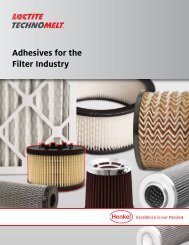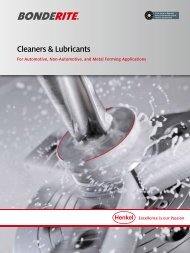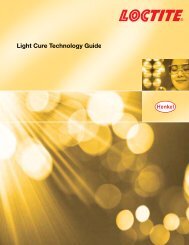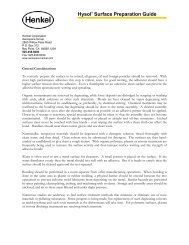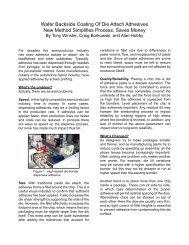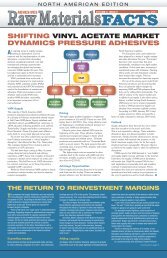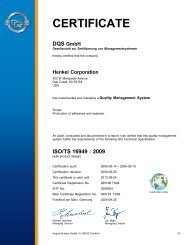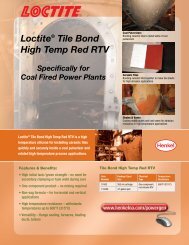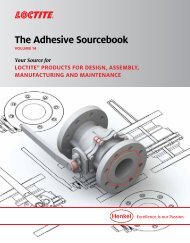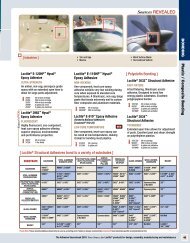Assembly of Plastic Adhesive Components
Assembly of Plastic Adhesive Components
Assembly of Plastic Adhesive Components
Create successful ePaper yourself
Turn your PDF publications into a flip-book with our unique Google optimized e-Paper software.
The new DVD formats with increased data densities present some challenges for assembly and<br />
in-line inspection. As with CD’s, warpage or disc tilt tolerance is critical to the playing<br />
performance <strong>of</strong> the disc.<br />
A DVD is comprised <strong>of</strong> two 0.6 mm polycarbonate discs with the same diameter as the single<br />
1.2 mm CD. The basic manufacturing process for DVD’s is very similar to that <strong>of</strong> CD’s except<br />
that additional equipment and tighter process controls are necessary to minimize tilt.<br />
Polycarbonate material is injection molded into a master disc. After injection molding, a layer <strong>of</strong><br />
aluminum is vacuum deposited onto the information encoded side <strong>of</strong> the disc, and the disc is<br />
then coated with a UV protective lacquer and cured. The .6 mm disc is then ready for bonding.<br />
Some DVD manufacturers have eliminated the lacquer coating step and instead have the<br />
adhesive double as a protective coating.<br />
The adhesive technology used for DVD bonding must be compatible with the substrate<br />
components, and be easily optimized and integrated into replication lines. The adhesive must<br />
also meet cycle time requirements, allow for easy handling and dispensing, maintain adequate<br />
environmental conditioning resistance, and produce minimal degradation <strong>of</strong> the performance <strong>of</strong><br />
the disc.<br />
<strong>Adhesive</strong>s currently used to bond DVD’s include UV curing acrylics, cationic UV epoxies, and<br />
hot melts. Hot melts can be used effectively only on DVD-5 single layer formats; cationic UV<br />
epoxies are effective on both DVD-5 single layer and DVD-10 double sided discs but require a<br />
UV lacquer protective coating prior to bonding. Free radical UV acrylics are the only adhesives<br />
currently on the market that can be tailored to meet the refractive index requirements necessary<br />
to allow the DVD reader to access information on all four layers <strong>of</strong> a double sided DVD-9 disc.<br />
Free radical UV acrylic adhesives are only available from Loctite, and can be applied via spin<br />
coating or capillary flow methods.<br />
Spin coating is the application method most common in the industry. The adhesive is applied to<br />
one disc half, the mating disc is then placed on top <strong>of</strong> the adhesive, and the assembly is spun at<br />
a high rpm to distribute an even film throughout the 120 mm disc. Once adhesive coating is<br />
completed, the mated discs are irradiated under UV light on an in-line conveyor system or rotary<br />
index table. The discs are then inspected to detect any defects that occurred during the<br />
assembly process.<br />
UV Cured-In-Place Compression Gaskets Increase Production, Reduce <strong>Assembly</strong> Costs<br />
(sidebar)<br />
Secoh Sangyo Co. Ltd., a leading manufacturer <strong>of</strong> pneumatic blowers, uses Loctite ® Fast<br />
Gasket cured-in-place compression gaskets to significantly reduce their material and labor<br />
costs and to increase overall productivity on their line <strong>of</strong> diaphragm blowers. The blowers pump<br />
and filter ambient air, and are an integral component in jacuzzi manufacturing.<br />
Before using Fast Gasket, polypropylene blower units were assembled manually by three<br />
workers. Two o-rings made <strong>of</strong> pre-cut EPDM were used for each unit: one on the housing case<br />
and the other on the inside chamber flange. The company had to maintain an in-house<br />
inventory <strong>of</strong> each gasket, which was made by a contracted vendor from a mold die.<br />
In deciding whether to use a liquid gasketing material, Secoh Sangyo had three requirements:<br />
1) it must seal the outer case to protect the blower from rain and dust; 2) it must maintain a tight



